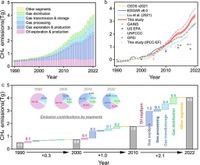Methane (CH4), a significant short-lived climate pollutant, is drawing increasing attention as China experiences rapid growth in its oil and gas sectors. A new study provides a comprehensive methane emissions inventory from Chinese oil and gas systems over the period from 1990 to 2022, driven by the energy transition towards natural gas usage.
The team constructed a methane emissions database involving refineries, facilities, pipelines, and production fields. They found that methane emissions from China's oil and gas systems rose significantly from approximately 0.5 teragrams (Tg) in 1990 to 4.0 Tg in 2022—a staggering eightfold increase. This rise is primarily attributed to the soaring demand for natural gas as the country attempts to reduce its dependence on coal.
The study, published in the journal Nature Communications, underlines that methane, while less persistent in the atmosphere than carbon dioxide, has a global warming potential that is 28 times greater over a century. Reducing methane emissions is increasingly seen as an essential strategy for combating climate change.
The Global Methane Pledge, initiated by the U.S. and the EU in 2021, aims to cut methane emissions by 30% relative to 2020 levels by the year 2030, as part of broader goals laid out in the Paris Agreement targeting net-zero emissions by 2050.
In their analysis, researchers highlighted that oil and gas systems are the leading sources of methane emissions globally, producing about one-quarter of the world’s human-caused methane releases, which amounted to roughly 360 Tg in 2017. Notably, the newly established Oil, Gas and Methane Partnership (OGMP), supported by major international bodies like the United Nations and European Commission, set a target to reduce methane emissions by 45% before 2025.
The emissions database compiled by the data team provides crucial insights into the trends and hotspots of methane emissions across China. It reveals that approximately 80% of the emissions tracked are related to field sources, with emissions being concentrated in regions with dense oil and gas infrastructure.
While the total emissions have grown, the data reveals significant shifts in the sectors contributing to methane outputs. The researchers indicated that the gas sector alone accounted for 95% of the total methane emissions growth. In a matter of just over two decades, the contribution from gas exploration and production saw a drastic increase from just 16% in 2000 to 45% in 2022.
This transition reflects the country's energy policies, aimed at improving air quality and reducing carbon footprints, as demand for cleaner energy sources has grown. Alongside this, oil sector emissions remained relatively flat, marking a pivotal shift in China's energy landscape.
As a part of their investigation, the researchers employed complex geospatial mapping techniques to identify emission hotspots and laid out the distribution of methane emissions across the country. They found that more than 90% of these emissions were concentrated on land, with the highest emission hotspots located in unconventional gas fields and Eastern China’s densely populated areas.
Provinces like Shaanxi were identified as key areas of concern, where methane emissions surged due to rapid development in natural gas production, particularly from unconventional sources. Notably, Shaanxi alone accounted for a whopping 30% of the national methane emissions in 2022, reinforcing the urgent need for targeted emission control strategies in these regions.
The implications of the findings are profound, suggesting that reducing emissions from gas production, transmission, and distribution should be a priority in China’s environmental policies moving forward. The researchers stress that addressing these emissions could significantly aid national efforts towards carbon neutrality by 2060.
Furthermore, the authors point out that the tools developed for this methane emissions database can assist in establishing necessary protocols for emission monitoring, thus enhancing efforts to mitigate methane output through upgraded monitoring and management systems.
In summary, the expansion of China's oil and gas systems has not only exacerbated methane emissions but also underscored the crucial need for comprehensive monitoring strategies and effective policies targeting emission reduction. The findings will provide a foundation for future analysis and enable policymakers to devise interventions aimed at effectively curbing greenhouse gas emissions from the oil and gas sectors.

